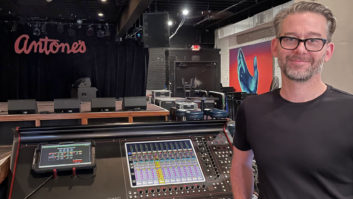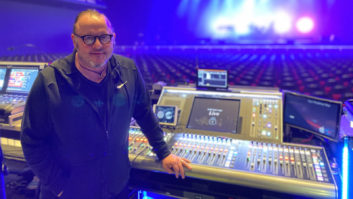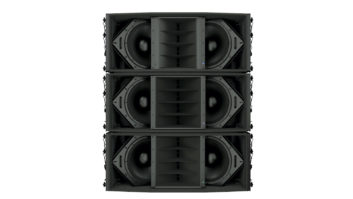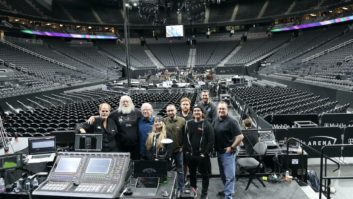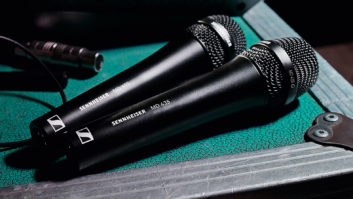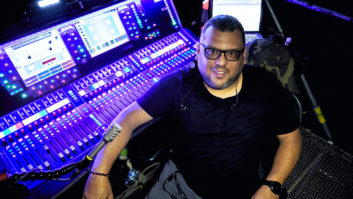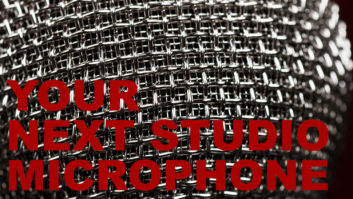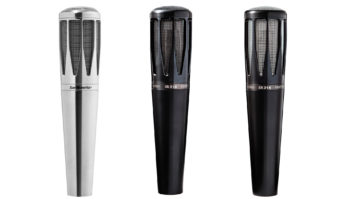It seems obvious that IEMs are leading the way to a clearer future, and for a variety of reasons. Sometimes it’s a purely practical decision. Simon Sayer, who mixed the Classic BRIT Awards concert at the Royal Albert Hall last June, pointed out that “some of the artists were performing on an LED floor, so having loads of wedges out would have spoiled the effect. It usually comes down to artist preference or logistics of staging. As a FOH engineer, having everyone on ears makes for a much better sound out front—but we don’t always have that luxury.”
But is it always such a luxury? Jon Burton has been mixing monitors and FOH for over 30 years, and would prefer to underline the continuing relevance of the techniques that IEM might otherwise abolish.
“Why are we still using stage monitors?” says Burton. “‘Why shouldn’t we?’ is the question! Monitoring is specialized sound reinforcement. We use sound sources to help balance the quieter elements with the louder ones to achieve a mix where the performer feels comfortable. My first foray into IEMs was in 1993 with The Cranberries, and initially Dolores [O’Riordan, singer] hated it. I was also doing monitors for Suede, and Brett [Anderson] wouldn’t even try it. Since then, we’ve seen a massive switch to in-ear monitoring. Has it helped? Yes. For many acts, it has given the musicians, particularly singers, a clear and consistent sound almost regardless of the venue. Has it made for better performances? Yes … maybe. Is it a perfect solution? No.”
Related: The Comfort of Consistency: Incorporating In-Ear Monitor Technology to the Festival World, by Strother Bullins, Oct. 23, 2014
For Burton, there is a particular trade-off between the acoustic security of in-ears and the greater musical integration of an act sharing the moving air of an open, if noisy, sound stage. “I hate doing a tour where it’s all on IEMs,” he continues. “It’s one of the reasons I don’t do monitors anymore. It leads to introspective listening practices. It can become very insular, musicians becoming obsessed with ‘their’ sound and not the ensemble. I like working with acts where the singer has a pair of wedges. It can mess up the FOH sound, but it can also help produce a greater ensemble performance. If you have a singer who can sing and who can listen, you can get a dynamic performance that I find is often missing when the band is reliant on IEMs.
“Of the last three acts I worked with, two of the singers were on wedges and the third on IEMs, but they were performing on a stage where the sidefill and keyboard fill were larger than most club systems. So don’t write off wedges yet; they still have their place. And we haven’t even gotten to the physicality of sound. It’s about feeling as well as hearing.”
It sure is. Witness the remarks of Michael Brennan, who has trod the boards with a huge range of acts from Primal Scream and Faith No More to KT Tunstall and, most recently, the Jesus and Mary Chain. “We were special guests with Nine Inch Nails in America,” he recounts, “and they had a completely silent stage: Every single thing, including guitars, was processed through Apple’s MainStage software and sent to in-ears. But even so, they had six V-DOSC 218s along the back of the stage pumping out subs so the band could feel it. Despite a really controlled, high-tech environment, there’s still a need for the movement of some air by loudspeakers. It was absolutely essential for the show, even if it was a bit of a nightmare at FOH.”
Jim Reid, the main vocalist in JAMC, has two purely cosmetic wedges at his feet, unconnected and bereft of signal. This is wedge-as-prop, which underpins the legacy of these boxes from rock ’n’ roll mythology if nothing else. A bank of implausible Marshall stacks in the backline, only 10 percent of which are working, will do the same. Whether real or not, wedges and other stage monitoring enclosures are fighting a rear-guard action against the clinical progress of in-ears. “Most tours have a mixture of both—even the older bands,” reflects Brennan, “who now realize that they have to protect their hearing a lot better.”
Health is probably the issue that will win the day, along with scalability. Both topics have exercised Chris Marsh, FOH engineer for Ed Sheeran, throughout the British star’s meteoric rise from modest solo gigs to mammoth solo gigs. Despite no change in his instrumentation or presentation, the sheer hike in venue capacity has necessitated an update in the monitoring solution, if not an upgrade, in creative terms.
Related: Recording Ed Sheeran at Wembley Stadium, July 18, 2018
“Ed started with just wedges, doing the pubs and clubs where in-ears are an expensive commodity,” Marsh reports. “He likes to hear the audience and walk in and out of the audio source, feeling the space around him. But as the gigs got bigger, the monitors got louder, and even with just an acoustic guitar and vocal, we ran out of headroom. I became concerned for his health! We did a 6,000-crowd marquee in Colombia and the noise was unbelievable; he couldn’t hear a thing. I looked at him and said, ‘This is where I have to start using in-ears, isn’t it?’ It’s now a necessity rather than a choice, and it has taken some of the pleasure out of playing; he pops out one of the ears frequently in order to be able to hear the crowd and sometimes play along with them.”
There are, however, wedge monitors at his feet. “We’ve kept them for two reasons,” Marsh explains. “Firstly, in case his in-ears go down for any reason, so he still has a reference; they’re 20 dB quieter than they used to be! And secondly, when he does pop out one earpiece, he still has audio in both ears—one in-ear, and the other using the wedges.”
According to Marsh, when Sheeran uses the wedges, they’re not loud and detailed enough to enable him to pitch correctly, or to build his famous loops using the custom foot pedals that help him create such rich musical textures as a single performer. For this signature technique, IEM is essential. “Nowadays the wedges are really for the banter with the audience,” adds Marsh. “If Ed had a choice, I think he would only use floor monitors; that’s where he’s most comfortable, but unfortunately, there’s a limit to what you can achieve.”
It seems, therefore, that something is always lost when earpieces build their inevitable barrier between the performer and the room—even for a solo act with a good deal of very intimate material, and not just the ensemble dynamics of a high-SPL production. Recognizing this, the loudspeaker manufacturers continue to invest generously in the stage monitor format, which lives on below the radar of stadium mega-tours in more modest circumstances.
An extended version of this story appeared on Pro Sound News Europe: ‘Don’t write off wedges yet’: Why we are still using stage monitors, by Phil Ward, Feb 13, 2019.
